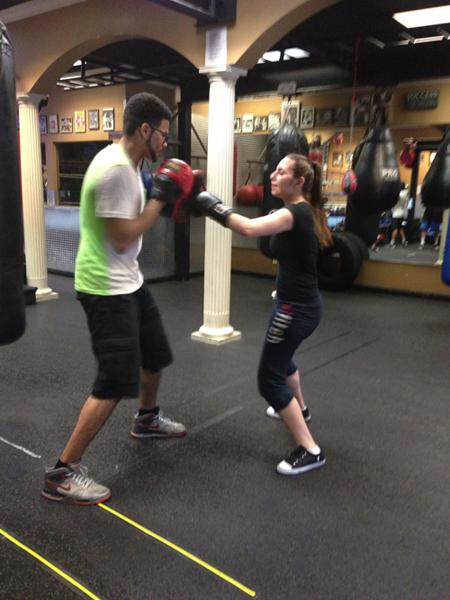Boxing, unboxing, reboxing

Boxing instructor Ian Porters teaches junior Krkasharian how to throw a hook during her first class.
“Push through,” yelled my boxing instructor Ian Porter at Gio’s Brooklyn Boxing Club in Burbank. “I know you can do it.” With beads of sweat rolling down my face, I used every ounce of strength left in my body after my first hour of boxing to throw one final punch onto the large, heavy, 150-pound punching bag. Loud hip-hop music blared in the background, and two advanced boxers sparred in the ring, with the air heavy and full of sweat. “Good work, everyone,” said Porter. “Be sure to get some healthy food in your system.”
I left the class with what felt like a ton of adrenaline flowing through my veins. All of a sudden, I felt as if a huge weight had been lifted off my shoulders, and I had an incredibly amount of energy.
At that moment, I felt invincible, as if I was able to do anything I set my mind to. I was certain that I just had to continue with these lessons. The only obstacle in my way was my parents.
It had been a struggle just convincing my parents to allow me to attend that first boxing class on Aug. 30. At first, both my mother and father had been completely against the idea.
“No,” my mother had firmly decided. “You are not going to boxing classes, and that is final.” Dismayed, I turned to my father for support, but even he agreed with my mother.
Even though I had already been attending karate lessons for more than four years, my parents felt that boxing was much too violent a sport for me to handle, mostly because they agreed with the common belief that boxing is primarily dominated by males. They were worried that I would get hurt and that the brief thrill I would feel was not worth the “danger” I was putting myself in.
I, on the other hand, felt otherwise, and I was determined to somehow persuade my parents to allow me to attend at least one class. I gave them both some time to think about the matter. I explained all of the health benefits that boxing offered and informed them that I would not have to actually spar with someone in the ring unless I chose to, as it was a beginner’s boxing class. Eventually, my parents gave in and allowed me to attend one lesson.
It turns out, there were some health benefits of the sport that even I did not know about. Contrary to the common belief that boxers only use their arms, a boxer’s typical conditioning workout actually involves the use one’s entire body. From doing squats and lunges to running up and down the stairs, my fellow classmates and I put every single muscle in our bodies to work. According to wellness and fitness specialist Penny Phang’s web page, boxing has been known to “improve the strength and flexibility of all muscle groups in the body;” however, the benefits of boxing do not end there.
As a matter of fact, the skeletal system is not the only one boxing helps develop. Normally, a boxer spars in the ring for three consecutive minutes, then is allowed a one-minute break. This pattern of working out and taking set breaks is called interval training. Interval training is commonly used in order to improve one’s cardiovascular fitness and health.
Even though I was not at the level required to fight in the ring, my instructor taught our beginner’s boxing class using interval training. We would do intense cardio exercises for three minutes then have a one-minute break to barely be able to catch our breath and drink some water. According to the Livestrong Foundation, those with healthy cardiovascular systems have less of a risk of cardiovascular disease and stroke, and they also have a reduced blood pressure. “I began to box because I wanted to be more fit and become healthier,” Eli Golliher, an advanced boxer at Gio’s Brooklyn Boxing Club, told me. “I feel so much stronger and self-assured now. It’s amazing.”
I eventually discovered that boxing has more than just physical benefits; it plays a key role in relaxing one emotionally. This may sound paradoxical, since boxing is viewed upon as an extremely violent sport, but boxing actually serves as an outlet for anger. According to Phang’s web page, boxing helps to eliminate stress and tension. Sure enough, I emerged from my first lesson relaxed, happy, and excited to continue the sport.
Even though it was only the first class, I was extremely sore afterwards. I remember thinking that it was the toughest workout I had ever done in my life. At the beginning of class, Porter had wrapped our hands with a cloth called a hand wrap, which protected our hands, and split us up into two groups.
One group would have to do squats and lunges for three minutes, while the other would have to run up and down the stairs. We had a water break for one minute, then switched. Those who worked on the stairs did squats and lunges and vice versa. We finished up conditioning with some more cardio and strength training, which included jumping jacks and push ups.
Next, Porter had us split up into small groups of two or three people and gave us combinations of punches to practice. At this point, he taught me the typical boxer’s stance. Normally, the boxer’s left leg is bent in front, while the right leg is slightly bent behind the left one. Most of one’s weight should be on one’s left leg, as one’s right heel must always remain off the ground. “The best part,” boxer Kimberly Tamay said, “is when you’re versing an opponent and you realize just how far you’ve come. You learn your own strengths and weaknesses. It brings you a lot of confidence.”
Tamay was one of the many female boxers at Gio’s Brooklyn Boxing Club. My parents and I were both surprised at the large amount of females who were determined to learn the sport, yet that fact motivated me and made me realize that it is possible for a female to master the art of boxing.
That day, I also learned the difference between a jab and a cross. A jab, I learned, is a punch thrown with the left hand. It is supposed to be light and quick; its purpose is to make your opponent lose his or her balance. On the other hand, a cross is thrown with one’s right hand and focuses more on strength. For both punches, one is supposed to pivot one’s body in the direction of the punch.
The boxer’s hands must always be clenched in a fist, protecting the torso, and be positioned near the cheeks. It took me some time to be able learn this position, as I am so used to positioning my hands near my hips when at karate, and I still have not perfected it. After practicing our jabs and crosses, Porter had us do some more push ups, then ended the lesson. He says, “I like seeing the kids progress. When I tell them to practice something at home, they come back having perfected whatever I asked them to work on.”
I begged my parents to let me continue boxing, as after that first time, I fell in love with the adrenaline rush boxing provided me. After seeing how much I loved the sport, my parents hesitatingly agreed to allow me to continue. The classes proved to be rather repetitive in their structure but were no less challenging than that first lesson. Each time, Porter helped me challenge myself, and I ended up learning something new each time I went.
Porter said he especially enjoys the individuality the sport provides. “I really like how boxing is so individual. With a team sport, you rely on everybody else, but in boxing, each individual has to push himself,” he said. Having more than four years of karate behind me, I am used to improving my weaknesses on my own, yet boxing pushes me to go one step further, building up my endurance every step of the way.







